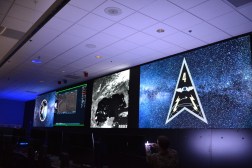Unclassified space strategy outlines how DOD will defend satellites in orbit

The Department of Defense’s office for space policy has published a new document defining the threats posed to U.S. space-based assets and how the Pentagon plans to keep them out of harm’s way.
Released on Thursday, the congressionally mandated report is an unclassified version of the DOD’s top-secret space strategy. During a call with reporters Wednesday ahead of the report’s publication, Assistant Secretary of Defense for Space Policy John Plumb called the document “the clearest and most comprehensive unclassified articulation yet of our approach to protecting national security interests in space.”
The unclassified version is in response to two separate directives from Congress — one in the 2022 National Defense Authorization Act to conduct an unclassified space policy review and another in the 2023 National Defense Authorization Act that called on the Pentagon and Office of the Director of National Intelligence to publish an unclassified space defense strategy.
“It made the most sense to bundle these two responses together because how we’re going to protect and defend our satellites and our interests in space is really inextricably linked with our policy,” Plumb said.
He emphasized that the strategy’s release to the public aims to help both the department and lawmakers disseminate the Pentagon’s missions and acquisitions related to space, as well as normalize the domain as an operating environment. As head of space policy, he has advocated against overclassification of programs and is pushing for continued reviews of declassification policies, he said.
The strategy elaborates on the three major lines of effort to the Defense Department’s approach to defending national security assets in space — mission assurance, space domain awareness and protecting the joint force from hostile actions.
“Space provides the U.S. military with indications and warnings of threats or attacks, command and control of forces across the globe, and monitoring of adversary activities,” the unclassified document states. “Competitors have seen U.S. military advantages enhanced and enabled by space capabilities for more than three decades. Competitors therefore seek to deny the U.S. ability to leverage space in crisis and conflict and are developing a range of capabilities to do so.”
The Pentagon is prioritizing more resilient architectures and developing strategies to best defend against counterspace threats, the report notes. Plumb emphasized those capabilities aren’t just satellites and payloads in orbit, but also the critical ground segments and links that connect them.
“We need to make sure the joint force continues to have access to needed space-based services to be able to fight and win,” he told reporters. “Deterrence requires combat credible forces, and our combat credible forces are underwritten by access to space.”
The strategy highlights a number of approaches the Pentagon can take to achieve space resilience — disaggregation, distribution, diversification, proliferation, protection and deception — but emphasized that different mission sets may require different single approaches or some combination.
For example, the Space Force has been focused on proliferating satellites carrying warfighting capabilities in low-Earth orbit with its Proliferated Warfighter Space Architecture constellation. By deploying hundreds of satellites of the same type, one satellite being attacked or neutralized is unlikely to affect operations.
The department has already redeveloped its space missile warning and missile tracking capability through new “resilient-by-design” approaches to architectures that resulted in a number of satellites carrying a range of capabilities across orbital regimes, the report notes.
Other force design studies are underway, including fire control to address long-range threats; tactical ISR to enable forward operations; a space data network to ensure data throughput for decision-making and battle management; and protect-and-defend operations to protect vital infrastructure and space-based capabilities, per the strategy.
Resilience is also achieved through protecting space systems from adversary counterspace threats, and the department is in the process of developing capabilities to defend its own platforms, as well as those from allies, partners and the commercial space sector when directed, according to the report.
Although the unclassified strategy does not explicitly apply to commercial systems that are used to support operations, Plumb said the Defense Department will protect and defend those commercial platforms if ordered to by U.S. political leadership. He emphasized that a reduction in overclassification can mitigate risk for commercial industry working with the department.
“One of the best ways it’s become clear is to help share threat information with industry partners so they can react,” Plumb noted. “That gets back to this issue of classification and making sure that we share information at the speed of relevance with our industry partners, so they can attend to their own systems.”
The Pentagon is focused on advancing its space domain awareness capabilities as its second line of effort. The mission set is a top priority for the Space Force, especially as that area becomes increasingly crowded with additional systems and debris.
Plumb noted that space domain awareness isn’t just about knowing what’s in space, but also what those systems are doing and how the environment is constantly changing. It requires fusing sensor data in order to provide a clear common operating picture.
“The ability to protect and defend our space systems relies heavily on our ability to detect, track and characterize objects in space, both routine activity and any hostile actions,” Plumb said in response to questions from DefenseScoop. “That drives us towards more investments in space domain awareness, which rely on an integrated system of sensors and data processing.”
The strategy’s third line of effort details how the department is protecting the joint force from adversaries’ deployment of space-enabled capabilities. The Pentagon is looking to diminish an enemy’s ability to attack U.S. assets by denying those threats “using a variety of reversible and irreversible means,” the report says. Those options could come from any domain and target any part of a hostile space architecture, it notes.
The strategy pointed to China’s work in developing space-based command-and-control systems and intelligence, surveillance and reconnaissance networks that enhance their operations, as examples of concern.
“In conflict, this may necessitate ensuring that our adversaries are unable to rely on their space-based services to find and strike our forces. We will leverage a breadth of options across all operational domains to do so if required,” Plumb said.
Meanwhile, Plumb said he’s been chairing quarterly meetings for a new body known as the Space Warfighting Activities Group. It serves as a venue for leaders across the Pentagon — such as Frank Calvelli, head of space acquisition and integration at the Department of the Air Force — and the intelligence community to discuss current challenges and opportunities for space warfighting policy and strategy.
Most of the content of those meetings is classified, but Plumb noted they serve a couple of purposes.
“One is to clear obstacles to individual components or satellites or systems that we’re trying to make sure succeed,” he explained. “A second one is, inside the building there are many, many different … components that work on space and have space interests, and having a place to bring all of these information together and socialize is really proving valuable.”
While the Pentagon will work to deter and deny hostile actions in space, the department still seeks to promote “responsible behavior” there, Plumb said. This is especially critical as space becomes more accessible and, in turn, more crowded.
“We have the responsibility to ensure we are moving forward in a way that focuses on deterring conflict and reinforcing the safety, security, stability and long-term sustainability of the space domain,” Plumb said.






